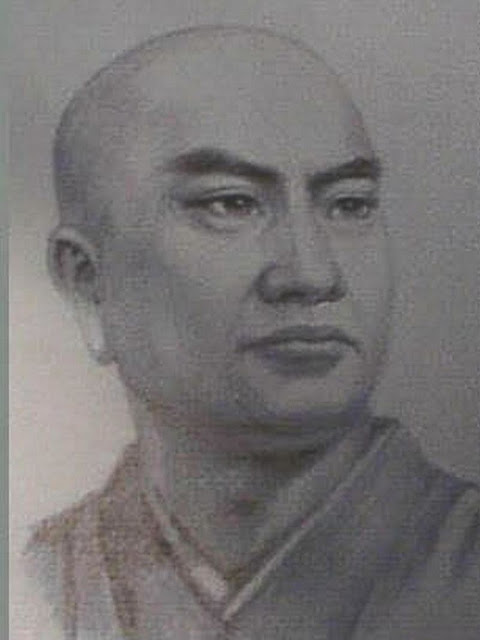Buddhism originated in
India in the 5th century. It derives from the teaching of the Buddha, who is
regarded as one of a series of such enlightened beings.
Nichiren was a Japanese Buddhist monk who lived during the Kamakura period in Japan, from 1222 to 1282. On April 28, 1253, he is said to have expounded the teachings of Namu Myōhō Renge Kyō for the first time on the beach at Tatsunokuchi in Japan. He believed that this sutra, which is also known as the Lotus Sutra, contained the essence of all the teachings of Shakyamuni Buddha, and he made it the foundation of his own teachings.
Nichiren's teachings emphasized the idea that all people, regardless of their social status, could attain enlightenment by chanting Namu Myōhō Renge Kyō, which means "I take refuge in the Lotus Sutra of the Wonderful Law." He believed that by chanting this phrase, people could tap into the inherent Buddha-nature that he believed existed within all beings.
Nichiren's teachings became known as Nichiren Buddhism, and it has since spread throughout Japan and around the world. His teachings have had a significant impact on Japanese culture and have inspired many people to seek enlightenment through chanting and other practices associated with the Nichiren school of Buddhism.
 |
| Nichiren |
In 1954, archaeologists excavating an 8th century Viking settlement in Sweden found a Buddha statuette from North India.
In November 2013, an international team of archaeologists digging under the Maya Devi Temple at the UNESCO World Heritage Site of Lumbini, Nepal discovered remains of an ancient tree shrine dated before 550 BC. It is possibly the earliest evidence of Buddhist structures ever found .The discovery was made at a site traditionally thought to be the birthplace of the Buddha, under a series of brick temples below the current temple.
Most Buddhists do not actually believe in God. Although they respect and look up to the Buddha, they do not believe he was a god but they worship him as a form of respect.
Buddha's sermon at Benares to
five fellow ascetics in a park, "turning of the Wheel of the Law," is
held in similar reverence by Buddhists as the Sermon on the Mount is by
Christians.
From its earliest history the
choral chanting of sacred texts has been an essential part of Buddhist liturgy.
Chants are learnt by repetition, though obscure notations exist in Japan, Tibet,
and Korea. The two basic forms are sutra, a simple syllabic recitative, and
gatha, using more elaborate melodies.
The main Buddhist
instruments--the ghanta (handbells), sankha (conch trumpet), vina (arched harp
or lute), tala (cymbals), and various types of drums, bells, and gongs.
The founder of Zen Buddhism, Bodhidharma, is said to have gained enlightenment by facing a wall for nine years and not speaking.
The founder of Zen Buddhism, Bodhidharma, is said to have gained enlightenment by facing a wall for nine years and not speaking.
Buddhists use tea during
periods of meditation as they claim it contributes to a worshiper's sense of
serenity.
In Japan initially tea was
drunk primarily by Zen Buddhist monks, but by the 13th century it had become a
popular beverage amongst the general population.
In medieval Japan, archery
became closely linked with the metaphysical system of Zen Buddhism. It became
part of the education of the noble Samurai and was practised not for such
purposes as the hunt or war, or purely aesthetic enjoyment, but to discipline
the mind. Archery was considered a lesson in effortless self-control, perfect
equanimity, and the attainment of utter detachment.
Before the Chinese takeover
of Tibet in 1952, 25 percent of the males in the country were Buddhist monks.
Alexandra David-Néel was an explorer who snuck into Tibet in the 1920s to learn about Buddhism when it was closed to outsiders. She lived until 101 and her writings influenced Jack Kerouac amongst others.
Actress Uma Thurman's father was the first Westerner to become a Tibetan Buddhist monk.
The actor Richard Gere is the best-known celebrity Buddhist, having developed an interest in his 20s. In 2001, Gere made an appearance (in animated form) in an episode of The Simpsons, in which he helps to convert Lisa Simpson. The character remains a follower of Buddhist teachings.
Alexandra David-Néel was an explorer who snuck into Tibet in the 1920s to learn about Buddhism when it was closed to outsiders. She lived until 101 and her writings influenced Jack Kerouac amongst others.
Actress Uma Thurman's father was the first Westerner to become a Tibetan Buddhist monk.
The actor Richard Gere is the best-known celebrity Buddhist, having developed an interest in his 20s. In 2001, Gere made an appearance (in animated form) in an episode of The Simpsons, in which he helps to convert Lisa Simpson. The character remains a follower of Buddhist teachings.
Tibetan Monks spend months carefully "pouring" colored sand to make a very detailed and complex museum-worthy artwork that is known as the "Sand Mandala". Mandalas are cosmic maps charting the succession of initiations from the historical Buddha 2600 years ago to present day, Once complete, these intricate paintings are then ritualistically destroyed and that symbolizes the Buddhist belief of impermanence.
Source The Oxford Interactive
Encyclopedia
No comments:
Post a Comment